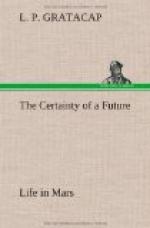There was much in our scientific work also that encouraged a certain high mindedness and liberty of speculation, a careless audacity before the most difficult tasks. The resolution of matter into a phase of energy, the interpretation of light as an electric phenomenon, the mysteries of the electric force itself, the peculiar hypotheses about the force of gravitation, lead men, studying these subjects, and endowed with speculative tendencies to conceive, moved also by a quasi sensational desire to reach new results, that the most extravagant achievements are possible to science.
With us, regarding the physical universe as a unit, recognizing the notes of intelligence of a deep coercive and comprehensive plan involved throughout, feeling that our human intelligence was the reflex or microcosmic representation of the planning, upholding mind, that if so, no conceivable limitation could be placed upon its expansion and conquests, that further it would be incomprehensible that the colonizing (so to speak) of the central mind occurred only on one sphere, when it doubtless might be embodied in other beings, on hundreds or thousands or millions of other spheres; that continuance of life after death was a truth; feeling all this, their concomitant influence was to make us positive that the human mind in an intelligent, satisfactory, self-illuminating way some day would reach mind everywhere in all its specific forms; and that the abyss of space would eventually thrill with the vibrations of conscious communion between remote worlds.
With feelings of this sort excited and reinforced by my father’s passionate hope to learn something of his wife’s life after death we reached Christ Church, New Zealand, in June, 1883.
I may now revert to the line of suggestions that led my father and myself to locate in Mars the scene, at least, as we surmised in part, of those phases of a future life which I am now able to reveal with, I think, positive certainty.
The planet Mars as being the next orb removed from the Sun after our own world in the advance outward from our solar center, has always attracted attention. At perihelion, when in opposition with the earth, it is 35 millions of miles from the earth, and its surface, as is well known from the drawings of Kaiser, the Leyden astronomer, and of Schiaparelli, Denning, Perrotin and Terby, has apparently revealed an alternation of land and water which, with the assumption of meteorological conditions, such as prevail on the earth, has gradually made it easy to think of its occupation by rational beings as altogether possible.
During the opposition of Mars in 1879-80, Prof. Schiaparelli at Milan determined for the second time the topography of this planet. The topography revealed the curious long lines or ribbons, commonly called canals, which seamed the face of our neighboring planet. In 1882 this observation was enormously extended. He then showed that there was a variable brightness in some regions, that there had been a progressive enlargement since 1879 of his Syrtis Magna, that the oblique white streaks previously seen, continued, and, more remarkable, that there was a continuous development day after day of the doubling of the canals which seemed to extend along great circles of the sphere. In 1882 Schiaparelli expected at the evening opposition in 1884 to confirm and add to these observations.




